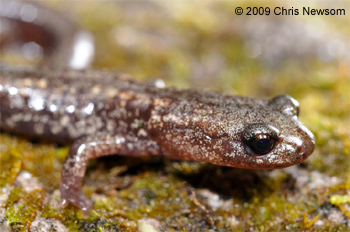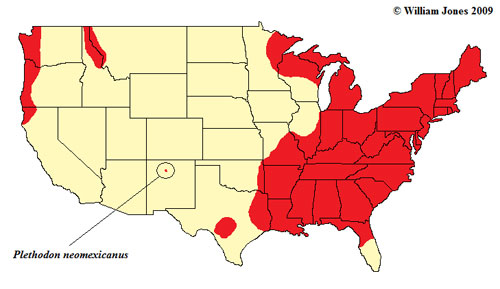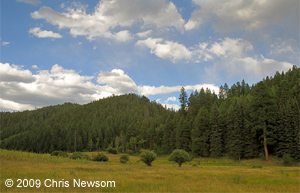| Plethodon neomexicanus | |||||||||||||
| Jemez Mountains Salamander | |||||||||||||

|
|
||||||||||||
The following article was written in 2009 for a local nature center newsletter in northern New Mexico.
The Jemez Mountains Salamander
The Jemez Mountains salamander (Plethodon neomexicanus) or JMS is a small woodland salamander that lives in the mountains surrounding the Valles Caldera. This salamander belongs to the genus Plethodon, which includes a total of 55 species, all in North America. Some readers may be familiar with its relative, the red-backed salamander (Plethodon cinereus), which is a very common and widespread species in the eastern half of the United States. In contrast to the wide distribution of the red-backed salamander, the range of the JMS is very small, with the species only existing in very specific habitats within a small geographical area.
The JMS, like all members of its family, lacks lungs and instead obtains oxygen directly through its skin. Since its skin serves as its only breathing organ, the skin has to be very thin and must stay moist in order for respiration to occur. Desiccation is quickly fatal, and thus the salamander requires a cool moist environment at all times.

How can a moisture-requiring salamander survive in New Mexico?
Several details of the animal's habitat allow its survival here. This salamander is found in mixed conifer and spruce-fir forests above 7,200 feet in very specific microhabitat conditions. Preferred microhabitat is generally characterized by relatively high humidity and soils that lie above a specific type of rock. Cracks in hard rock allow the salamander to take refuge underground, where cool moist conditions are available year round. They do not live in areas characterized by tuff rock. They occur only in shady wooded sites, particularly steep north-facing slopes that have a good cover of soil and plant debris. They have been found at altitudes above 11,000 feet. Thus, they are restricted to only the coolest and most moisture-retentive microhabitats that exist in this area.
Another characteristic that allows the survival of this salamander here is its reproductive strategy. Salamanders of the genus Plethodon do not require standing water in order to reproduce. Their eggs are laid on land, and the embryos pass through the larval stage while still inside the eggs. Thus, these salamanders can live in areas where there are no bodies of water of any kind. An interesting fact is that no one has ever seen a clutch of eggs of this species in the wild. Most likely, the eggs are deposited underground, perhaps in the rocky cracks underground where the salamander takes refuge much of the time.

Range map for the genus Plethodon in the USA. P. neomexicanus is very much isolated from all other species in its genus.
How did this salamander get here?
Looking at the distribution of the genus Plethodon, it is clear that the Jemez salamander was not a geologically "recent" arrival. It is a slow-moving creature that cannot cover large distances in the course of its life, so it didn't walk here from a nearby population. It has no nearby relatives from which it could have recently evolved. So how did it end up here?
The distribution of this salamander tells us something about past climate changes in North America. Members of the genus Plethodon occur on both the eastern and western sides of the continent. Interestingly, some other groups of animals with a low dispersal ability also have this pattern (certain spiders, for example). It is likely that periods of cool, wet climate allowed for the spread of these animals across the continent and that that plethodontid salamanders were once widespread in the Southwest. In contrast, periods of warmer climate were associated with restrictions in the animals' ranges to small areas of suitable habitat. Because separation of a species into isolated units fosters the evolution of that species into multiple separate species, drier hotter periods in the geologic past probably produced the abundance of species found in the genus Plethodon. The hot dry climate of the Southwest within historic times has kept the Jemez Mountains salamander restricted to its small niche of suitable habitat. This species serves as a reminder that the climate of the Southwest has not always been as we know it.
Why is this salamander an endangered species?

P. neomexicanus habitat, Sandoval County
In the state of New Mexico, the JMS is listed as an endangered species. The reasons that the species is considered endangered are described as habitat loss, degradation and fragmentation. The loss of habitat has been largely the result of logging and fires. However, the underlying reason for the vulnerability of this salamander is its restricted range of suitable habitat. Even before human impacts, this salamander was holding out within small "islands" of suitable habitat. This salamander appears to need a very specific geology and forest cover in order to survive in New Mexico.
The forests with known populations of this salamander are now protected from further logging. Future threats to this salamander include any other changes that may further the loss of its habitat. Fire is an ever-present danger, as it destroys both the tree canopy, which keeps an area cool, and the ground cover, which the salamander uses for refuge. There was a documented decrease in the population of these salamanders following the Dome Fire of 1996. Other threats come from human impacts, such as climate change and the use of land for recreation.
Our region of New Mexico is host to a number of threatened and endangered species, and these species are all deserving of our protection. The Jemez Mountains salamander is truly a local treasure.
2013 Update
In October 2013, Plethodon neomexicanus was listed as Federally Endangered. Additional information is available from the U.S. Fish & Wildlife Service species profile, linked below.
References
Vieites, DR, Min, M-S, Wake, DB. 2007. Rapid diversification and dispersal during periods of global warming by plethodontid salamanders. Proceedings of the National Academy of Sciences, USA. 104(50):19903-19907.
Niman, M. 2004 Ring of Fire: Jemez Mountains salamander faces fire, fungus, and drought. New Mexico Wildlife. 49(3): 11-13.
Biota Information System of New Mexico (BISON-M), New Mexico Game and Fish. Accessed March 12, 2009. http://www.bison-m.org/
U.S. Fish & Wildlife Service Species Profile: Jemez Mountains salamander (Plethodon neomexicanus) https://ecos.fws.gov/ecp0/profile/speciesProfile?spcode=D019. Accessed November 15, 2013.
Other articles
Sentinels of Climate Change, Kirsten Fox, LANL 1663, Spring 2023.
Our Local Salamander blog post by Chuck Hathcock, 2010.
©2013 Jennifer Macke, 2009. Updated Nov. 2013. Links to other articles added 2023.
